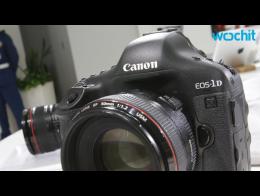The Canon 700D has long been one of our
favourite cameras, the brand has long become synonymous with DSLRs
(along with Nikon of course) and this is one of its greatest mid-range
models of all time. However, cameras aren't novels or albums and so it
must eventually stand aside for something better still. In this case
that'll be the Canon 750D and 760D,
the two cameras are technically identical but the 760D caters for
enthusiasts (with a top-mounted information LCD and extra mode dial)
while the more basic 750D has less controls and is aimed at novices who
still want good image quality.
Of course with those two cameras coming out, you'll see some
bargain prices on the 700D, so is it worth considering this older model?
The 700D has become the mainstay of Canon's range but not for much longer ...
The old 600D and its predecessors also suffered from various niggling problems. Autofocus was painfully slow in live view mode, and even worse when recording videos. We also found that the main autofocus sensor (when shooting with the viewfinder) often struggled to get pixel-sharp results from with the 18-55mm kit lens. This left users with the unfortunate choice of fast or reliable focusing – not the sort of decision we'd want to make after spending over £500 on a camera.
... as it's about to be replaced by not one but two new models
The 700D was amongst the subtlest updates in the product line in its eight year history. Compared to the old Canon 650D, there's a new EF-mount kit lens, a couple of subtle cosmetic changes (not counting the product name badge) and the ability to preview creative filters when composing shots in live view mode.
It may be a subtle update, but it's worth paying the extra for the new kit lens – and also the phase-detect autofocus points that are integrated onto the main imaging sensor, which were introduced in the 650D. The new lens has the same optical specifications as the old one, but its STM suffix (short for stepping motor) indicates that it's designed for smooth operation when recording videos. Most SLR lenses are designed to jump quickly to the required focus. This one can do this when focusing for photos, but in video mode it glides smoothly and silently while recording. The touchscreen – another feature that was introduced for the 650D – plays a valuable role here too, allowing a touch-for-spot-focus function, complete with subject tracking.
The new lens performs a little better than the old one in live view mode, too. It typically took about a second from pressing the shutter button to taking a photo, and a total of 4.2 seconds from one shot to the next. These aren't great results by any means, but it did allow us to take a few snaps with the camera at waist level without having to get on our knees to look through the viewfinder. It's a little faster than the 650D, and a massive improvement over the 600D.
700D vs 600D live view autofocus test
Best of all, we're delighted to report that we didn't experience any focus accuracy issues with the new lens when shooting with the viewfinder. With the old kit lens, when we took two shots, one with the viewfinder, another in live view mode, the second one was often slightly sharper. This time, there was no consistent difference between the two.
Otherwise, the 700D is essentially the same camera as the 650D, and by and large that's a good thing. The controls are well laid out, with a generous quota of labelled, single-function buttons. Pressing the Q button turns the LCD screen into a touchscreen control panel, giving quick access to a wider range of functions. The touchscreen speeds up main menu navigation, too, although the normal controls still work for those who prefer buttons. The 3in screen is pin sharp, and its articulated design is a great asset for video and live view shooting; you can flip it out for self-shooting or for reference when filming, or angle it upwards or downwards when shooting subjects at angles that would be awkward for fixed screen digital SLRs. It's very bright, too, meaning you can easily see your subject when shooting outdoors on a bright day.
A good range of controls and an articulated screen
HDR bracketing makes a return from the 650D, and Canon's free Digital Photo Professional software provides a simple way for amateur photographers to try their hand at high dynamic range images, but it's still limited to three exposures; there's no way to opt for a 5-shot bracket without trading up to a more expensive professional dSLR.
The 700D has become the mainstay of Canon's range but not for much longer ...
Canon Doubles Down on Point-and-Shoots With the G3 X
 video playing
video playing- FTC to Review Complaint Against Google's YouTube Kids App

- YotaPhone 2 review: The 5-inch dual-screen handset is back

- Super Smash Bros. For Wii U Review: Nintendo’s Signature Fighter Triumphs

- Hotel Charges Couple After Bad Online Review

- Iphone 6 plus review great for gamers

Design and features
Canon undoubtedly makes some fantastic SLRs, but for its three-digit consumer models, we've found in the past that this reputation is somewhat unwarranted. Perhaps this is because rivals have had to try that little bit harder to compete. The Nikon D5200 has a 39-point autofocus sensor, compared to the 700D's nine points. The Pentax K-30 has a significantly larger viewfinder and dual command dials – features that are only available in pricier EOS models.The old 600D and its predecessors also suffered from various niggling problems. Autofocus was painfully slow in live view mode, and even worse when recording videos. We also found that the main autofocus sensor (when shooting with the viewfinder) often struggled to get pixel-sharp results from with the 18-55mm kit lens. This left users with the unfortunate choice of fast or reliable focusing – not the sort of decision we'd want to make after spending over £500 on a camera.
... as it's about to be replaced by not one but two new models
The 700D was amongst the subtlest updates in the product line in its eight year history. Compared to the old Canon 650D, there's a new EF-mount kit lens, a couple of subtle cosmetic changes (not counting the product name badge) and the ability to preview creative filters when composing shots in live view mode.
It may be a subtle update, but it's worth paying the extra for the new kit lens – and also the phase-detect autofocus points that are integrated onto the main imaging sensor, which were introduced in the 650D. The new lens has the same optical specifications as the old one, but its STM suffix (short for stepping motor) indicates that it's designed for smooth operation when recording videos. Most SLR lenses are designed to jump quickly to the required focus. This one can do this when focusing for photos, but in video mode it glides smoothly and silently while recording. The touchscreen – another feature that was introduced for the 650D – plays a valuable role here too, allowing a touch-for-spot-focus function, complete with subject tracking.
The new lens performs a little better than the old one in live view mode, too. It typically took about a second from pressing the shutter button to taking a photo, and a total of 4.2 seconds from one shot to the next. These aren't great results by any means, but it did allow us to take a few snaps with the camera at waist level without having to get on our knees to look through the viewfinder. It's a little faster than the 650D, and a massive improvement over the 600D.
Video of k6kR7q_NTv0
Best of all, we're delighted to report that we didn't experience any focus accuracy issues with the new lens when shooting with the viewfinder. With the old kit lens, when we took two shots, one with the viewfinder, another in live view mode, the second one was often slightly sharper. This time, there was no consistent difference between the two.
Otherwise, the 700D is essentially the same camera as the 650D, and by and large that's a good thing. The controls are well laid out, with a generous quota of labelled, single-function buttons. Pressing the Q button turns the LCD screen into a touchscreen control panel, giving quick access to a wider range of functions. The touchscreen speeds up main menu navigation, too, although the normal controls still work for those who prefer buttons. The 3in screen is pin sharp, and its articulated design is a great asset for video and live view shooting; you can flip it out for self-shooting or for reference when filming, or angle it upwards or downwards when shooting subjects at angles that would be awkward for fixed screen digital SLRs. It's very bright, too, meaning you can easily see your subject when shooting outdoors on a bright day.
A good range of controls and an articulated screen
HDR bracketing makes a return from the 650D, and Canon's free Digital Photo Professional software provides a simple way for amateur photographers to try their hand at high dynamic range images, but it's still limited to three exposures; there's no way to opt for a 5-shot bracket without trading up to a more expensive professional dSLR.




0 komentar:
Posting Komentar